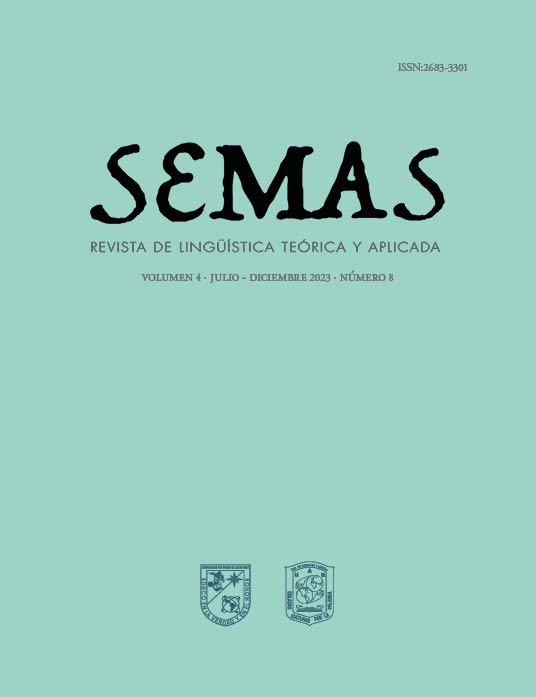Abstract
This article observes how a young return migrant enrolled in a cross-border university participates in social networks, in order to learn about his translingual practices (García and Wei, 2014) and understand the meanings behind them. A contextualization of the phenomenon of return migration between the United States and Mexico is provided, as well as the social and political conditions that contribute to the return of migrants. The relationship between social networks, return migrant youth, and the use of language to build identities as translingual youth is explored. A Discourse-Centered Online Ethnography (Androutsopoulos, 2008) is used to observe the online practices of this participant, and it is found that through his translingual practices he expresses his emotions; shows empathy and activism towards certain social causes; he selects the elements of his repertoire according to his audience; he practices economy of language and shows his familiar and unique repertoire.
References
Androutsopoulos, J. (2008). “Potentials and limitations of discourse-centered online ethnography”. Language@Internet, 5(9). https://www.languageatinternet.org/articles/2008/1610
Androutsopoulos, J. (2015). “Networked multilingualism: Some language practices on Facebook and their implications”. International Journal of Bilingualism, 19(2), pp. 185-205. https://doi.org/10.1177/1367006913489198
Baker, C. (2001). Foundations of Bilingual Education and Bilingualism. Bristol: Multilingual Matters Ltd.
Block, D. (2007). Second language identities. London: Continuum.
Canagarajah, S. (2013). Translingual Practice: Global Englishes and Cosmopolitan Relations. Nueva York: Routledge.
Castañeda, L., & Camacho, M. (2012). “Desvelando nuestra identidad digital”. Profesional de La información, 21(4), pp. 354-360. https://doi.org/10.3145/epi.2012.jul.04
Cataño Pulgarín, S. y Morales Mesa, S. (2015). “La migración de retorno. Una descripción desde algunas investigaciones latinoamericanas y españolas”. Revista Colombiana de Ciencias Sociales, 6(1) pp. 89-112.
Cenoz, J. (2020). “La competencia comunicativa y el enfoque plurilingüe en la enseñanza de lenguas”. En J. Ballester y N. Ibarra-Rius (Eds.), Entre la lectura, la escritura y la educación (pp. 165-180). Madrid: Narcea.
Christiansen, M. S. (2016). “‘¡Hable Bien M’ijo o Gringo o Mx!’: language ideologies in the digital communication practices of transnational Mexican bilinguals”. International Journal of Bilingual Education and Bilingualism, 21(4) pp. 439-450. http://dx.doi.org/10.1080/13670050.2016.1181603
Cohen, L., Manion, L. y Morrison, K. (2007). Research methods in education. London: Routledge.
Cummins, J. (2008). “BICS and CALP: Empirical and theoretical status of the distinction”. En B. Street & N. H. Hornberger (Eds.), Encyclopedia of Language and Education, (vol. 2, pp. 71-83). New York: Springer Science + Business Media LLC.
Cresswell, J. W. (2007). Qualitative inquiry and research design: choosing among five approaches. Thousand Oaks, CA: SAGE Publications.
Dekker, R. & Engbersen, G. (2014). “How social media transform migrant networks and facilitate migration”. Global Networks, 14(4), pp. 401-418. https://doi.org/10.1111/glob.12040
Donath, J. y Boyd, D. (2004). “Public Displays of Connection”. BT Technology Journal, (22), pp. 71-82. https://doi.org/10.1023/B:BTTJ.0000047585.06264.cc
Duffy, B. E. & Chan, N. K. (2019). “‘You never really know who’s looking’: Imagined surveillance across social media platforms”. New Media & Society, 21(1), pp. 119-138. https://doi.org/10.1177/1461444818791318
García, O. & Wei, L. (2014). Translanguaging: Language, Bilingualism and Education. London: Palgrave Pivot.
Instituto Nacional de Estadística y Geografía (2021, 22 de julio). Encuesta Nacional sobre Disponibilidad y Uso de Tecnologías de la Información en los Hogares 2020. [Comunicado de prensa número 352/21]. www.inegi.org.mx/contenidos/saladeprensa/boletines/2021/OtrTemEcon/ENDUTIH_2020.pdf
Lam, W. (2009). “Multiliteracies on Instant Messaging in Negotiating Local, Translocal, and Transnational Affiliations: A Case of an Adolescent Immigrant”. Reading Research Quarterly, 44(4), pp. 377-397. https://doi.org/10.1598/RRQ.44.4.5
Martinet, A. (1964) Économie des changements phonétiques. Traité de phonologie diachronique. Berna : A. Francke S. A.
Montoya Ortiz, M. S. y González Becerril, J. G. (2015). “Evolución de la migración de retorno en México: migrantes procedentes de Estados Unidos en 1995 y de 1999 a 2014”. Papeles de población, 21(85), pp. 47-78. http://www.scielo.org.mx/scielo.php?script=sci_arttext&pid=S1405-74252015000300003&lng=es&tlng=es
Norton, B. (2013). Identity and Language Learning: Extending the Conversation. Blue Ridge Summit: Multilingual Matters. https://doi.org/10.21832/9781783090563
Norton, B. (2016), “Identity and Language Learning: Back to the Future”. TESOL Q, 50(2), pp. 475-479. https://doi.org/10.1002/tesq.293
Otheguy, R., García, O. & Reid, W. (2015). “Clarifying translanguaging and deconstructing named languages: A perspective from linguistics”. Applied Linguistics Review, 6(3), pp. 281-307.
Pavlenko, A. (2006) “Bilingual selves”. En A. Pavlenko (Ed.), Bilingual minds (pp. 1-33). Bristol: Multilingual Matters.
Pavlenko, A. & Blackledge, A. (2004). Negotiation of identities in multilingual contexts. Clevedon: Multilingual Matters.
Ramirez, M. J. (14 de febrero 2022). Uso de redes sociales en México: más de 102 millones acceden al social media, la mayoría a Whatsapp. Marketing4ecommerce México. https://marketing4ecommerce.mx/uso-de-redes-sociales-en-mexico/#:~:text=De%20acuerdo%20con%20el%20estudio,diversas%20plataformas%20de%20social%20media
Solmaz, O. (2018). “Multilingual and multimodal repertoires as part of identity management on facebook: A case of international students”. Journal of International Students, 8(4), pp. 1662-1680. https://doi.org/10.5281/zenodo.1468066
Tapscott, D. (2009). Grown up digital: how the net generation is changing your world. Nueva York: McGraw-Hill.
Valdéz-Gardea, G. C. (2012). “Introducción”. En G. C. Valdéz-Gardea, Movilización, migración, y retorno de la niñez migrante. Hermosillo: El Colegio de Sonora.
Vogel, S. & García, O. (2017). “Translanguaging”. Oxford Research Encyclopedia of Education. https://doi.org/10.1093/acrefore/9780190264093.013.181
Zúñiga, V. y Hamann, E. T. (2008). “Escuelas nacionales, alumnos transnacionales: la migración México / Estados Unidos como fenómeno escolar”. Estudios Sociológicos, 26(76), pp. 65-85.

This work is licensed under a Creative Commons Attribution 4.0 International License.
Copyright (c) 2023 Semas

